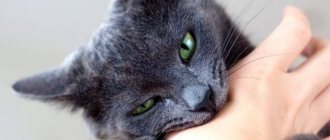Owners of cats may encounter an unusual condition of the animal: the cat is trembling as if it is cold. The owners see the reason that the pet is simply cold.
But the frequent repetition of this phenomenon serves as a signal that pathological processes are developing in the animal’s body, the animal is experiencing severe stress, and has become infected with an infectious disease.
Unreasonable trembling should be a reason to contact a veterinary clinic to a specialist, where the doctor will identify the presence of disorders and prescribe treatment.
The cat is shaking - the main reasons
Tremor (whole body trembling) is a rhythmic muscle contraction caused by internal or external factors, such as:
- change in temperature,
- reaction to stressful situations,
- sexual arousal,
- pathology.
- Cold, heat.
If the animal begins to tremble, having wet its skin, this behavior is normal. The furry predator is able to withstand low air temperatures, but does not tolerate humidity well.
The problem is especially urgent for a kitten; self-regulation of the body in babies is still weak, they are especially sensitive to humidity, but the development of seizures indicates a serious illness. Overheating of the body can lead to heatstroke, which in turn leads to tremors.
- Fear.
Attentive owners notice that the pet’s behavior when seeing unfamiliar people or things looks like this: the body begins to shake from small tremors. Fear of the unknown, especially fear, causes symptoms such as tremors of the limbs and involuntary urination.
- Emotional excitement.
Strong emotions (negative or positive) can cause involuntary muscle contractions. The cat is trembling not because of poor health, but from joy after a long separation from the owner, and so on.
- The period of sexual hunting.
An animal in heat often trembles when it sees an individual of the opposite sex. The hormonal surge that begins when looking at a potential partner leads to trembling. If trembling occurs in an animal after sterilization, you should have your pet checked by a veterinarian.
Be sure to read:
Otitis in cats: symptoms and treatment, description, treatment with medications and folk remedies
What treatment is prescribed?
After making a diagnosis, the veterinarian will tell you what to do next and prescribe an individual treatment regimen. Tremor that occurs for physiological reasons does not require special treatment. The animal should be protected from stress factors and ensure that it is less nervous and worried. To prevent your cat from suffering from tremors and hormonal surges during the period of estrus, you should take care of finding a partner in advance, and if breeding offspring is not included in your plans, then it is recommended to undergo sterilization surgery.
In addition to basic treatment, it is important to include vitamin supplements in your pet’s diet that will help strengthen the immune system.
If the root cause of tremors is any internal pathology, a comprehensive treatment regimen is prescribed to get rid of the original source of the problem. In addition to taking medications, the owner should take care of the nutrition of his four-legged friend. After all, if a cat eats low-quality food, this also negatively affects its health and causes tremors. If there are problems with the kidneys and organs of the urinary system, experts advise switching the cat to holistic food. In addition, after consulting with a veterinarian, it is useful to periodically give your pet special vitamin and mineral supplements that support the immune system and increase the body’s resistance to the effects of negative external factors.
When to contact a veterinarian
If your cat often trembles and there are additional signs of ill health (increased aggression, lethargy, frequent bowel movements, vomiting, constipation), you should immediately visit a veterinary clinic.
- Tremor can be one of the symptoms when affected by toxic substances. The poison in the cat’s body is absorbed gradually, slight trembling is replaced by convulsions.
- Minor trembling coupled with lethargy may indicate the development of an infection.
- Infection with worms is accompanied by constipation or diarrhea, perversion of taste, and chills.
- Shaking of the entire body and head may indicate internal injuries.
- A tick bite may also be accompanied by trembling.
- Chills, accompanied by coughing, sneezing, and discharge from the sinuses, indicate damage to the bronchi and pneumonia.
- Damage to the meninges as a result of the development of meningitis, tick-borne encephalitis, borreliosis, rabies, is often accompanied by severe trembling and convulsions.
Caution - rabies
If the cat is free-range, its behavior must be observed especially carefully. On the street there is a high risk of contracting various infectious diseases, many of which are fatal.
Having noticed a twitching of the tail and back of a freedom-loving cat, the owner needs to sound the alarm and find out why this is happening. These symptoms are often used to identify rabies. This disease is dangerous for both the pet and its owner. It threatens irreversible damage to the spinal cord and brain. In addition to the fact that the animal begins to twitch its tail and back, there are other signs of rabies:
- the cat eats food but refuses to drink water;
- the animal becomes aggressive or, conversely, tries to hide from people;
- have difficulty swallowing food;
- saliva is produced profusely;
- the pet begins to constantly bite itself at the place through which the infection entered the cat’s body.
But whatever the symptoms, only a veterinarian can accurately answer the question of why the cat is twitching its tail. However, if rabies is confirmed, the animal will have to be euthanized.
What to do if your cat is shaking
If an animal exhibits involuntary trembling, the owner should:
- analyze previous events,
- exclude external factors (hypothermia, overheating, fear, sexual overstimulation),
- contact a veterinarian to diagnose the disease and begin treatment in time.
Do you know what to do if your pet is shaking due to external reasons?
- In case of hypothermia, warm the animal, dry the skin, and massage the body.
- In case of overheating, cool the body with cool compresses and inject water into the oral cavity from a syringe without a needle.
- In case of stress, calm the pet down and protect it from objects that cause fear.
- During sexual hunting, you need to carefully monitor the pet’s condition and give medications that reduce attraction to the opposite sex.
Causes of seizures in cats
If a cat has seizures, you need to look for the reasons quickly and using laboratory and clinical tests. Self-treatment using recipes from the Internet is unacceptable.
Convulsions in kittens and adult animals are observed with the following pathologies.
Damage to the brain or nervous system
In cases of inflammatory diseases of the meninges, in addition to seizures, cats exhibit other symptoms. Most likely, there will be a rise in temperature and hysterical meowing, indicating pain.
Meningitis and tick-borne encephalitis. Let us dwell separately on particularly dangerous diseases. Meningitis and encephalitis in a cat causes tremors of the entire body, and not just its individual parts. Therefore, if a cat is trembling all over for no apparent reason, urgent diagnosis is needed.
Lyme disease. Sometimes nervous phenomena and convulsions due to borreliosis (Lyme disease) appear several months after the tick bite. In this case, joint diseases, lameness, lack of coordination, and uncertainty in movements are added to them. A few drops of blood are enough to laboratory confirm or refute the disease.
Rabies. If a cat has been bitten by another animal, foams at the mouth and exhibits convulsions, then rabies should be suspected. The animal is immediately locked in a cage and observed for at least 10 days. You need to know that the pet may not have been bitten, but saliva containing the virus could, upon contact with a sick animal, get on the mucous membranes, for example, the eyes, which is also fraught with infection.
Hypoxia. Oxygen starvation in cats can occur due to blood loss and blood diseases. Sometimes the process takes place after a fight between relatives. However, the cat community is structured wisely - the weak one simply retreats, preventing such serious injuries.
Toxoplasmosis. This is an infectious disease of humans and animals resulting from Toxoplasma infection. Apart from the fact that the cat is lethargic and sometimes trembles, toxoplasmosis may not show any other symptoms. The disease often has a hidden course. But in some cases the following will also appear:
The signs may disappear, but the fact that the cat is constantly trembling should alert you and force you to see a doctor to conduct serological tests to detect antibodies.
Toxocariasis and toxascariasis. Often helminths cause nervous phenomena. The cat is shaking not from the very presence of roundworms in the intestines (although with a large accumulation and blockage this is possible), but from the toxins that Toxocara releases into the host’s body. The waste products of the parasite, acting on nerve cells and ganglia, disrupt conductivity and cause convulsions.
If the intestines are clogged with roundworms, then the kitten may tremble after eating. During this period, the full stomach puts pressure on the intestines - and the roundworms intensify their movement, which causes twitching.
If the animal is not preventively dewormed every quarter, then worms can also cause epileptic seizures. In this case, they will be joined by:
But these signs can also occur with rabies, so you need to be careful.
Epilepsy. Epileptic seizures in cats are also accompanied by convulsions. The causes of this disease can be different, for example, trauma. But in any case, an epileptic seizure is only a symptom of the underlying pathology - improper functioning of the brain.
Physiological tremors
Physiological tremors do not occur very often in cats, but they do occur, and treatment for this condition is not required. Most often, in such a situation, trembling of the cat’s paws may begin first, and then trembling from the hind limbs gradually spreads to the pet’s back and sometimes completely covers the entire body. The main natural causes of trembling in a cat are as follows:
:
- Strong excitement with frequent rising on its hind legs - this behavior is usually observed when the cat smells a favorite treat on the table. The animal tries with all its might to show its owner that it needs to get a treat, without which it simply cannot live. From excitement and strong tension in the hind legs, on which the cat constantly rises, trembling develops, which goes away within 10-15 minutes. The condition is not dangerous and completely natural;
- Prolonged exposure to cold - if a cat that walks freely on the street has been sitting in ambush for a long time in the cold season, it can easily experience tremors in its hind legs. It is in them that blood circulation is most disrupted by exposure to low temperatures. In such a situation, trembling is necessary in order to restore blood circulation as quickly as possible. As soon as the animal's blood flow is restored, the trembling will go away. This cause of concern does not cause concern, unless, of course, the cat is very cold and is not in danger of catching a cold;
- Strong sexual arousal in a cat - this phenomenon is observed if a young cat smells a cat in heat, but does not have access to it. The animal begins an active search for a female, meows loudly, and from excitement its paws begin to tremble slightly. Most often, the phenomenon affects the hind legs, due to their close location to the genitals, and therefore an excited cat on shaky legs in such a situation does not look and is not sick. The front legs and head usually do not tremble.
- Fear - sometimes it is not clear to the owner, when, for example, a cat sitting on the windowsill begins to tremble as if for no reason. The problem is not ill health at all, but the fact that she saw an unfamiliar cat or dog.
Usually, the physiological causes of trembling of a cat’s hind legs do not cause concern to the owner, since even by eye it is clear that the cat is completely healthy. On an intuitive level, a person feels that the pet does not need help, and although the paws are shaking quite noticeably, the animal continues to thrive.
Locomotor activity of kittens during sleep
Researchers explain why a kitten twitches in its sleep much more often, more energetically and longer than its adult relatives. They claim that a young cat between the ages of birth and one and a half years has a long REM sleep phase, which takes up to 80% of his total rest time. During the period of active growth and maturation in animals, the nervous system is in the stage of development and formation, therefore, during sleep, kittens experience more vivid emotions than sexually mature individuals.
It is normal for a cat to twitch slightly during sleep once it has passed adolescence. Adaptation of an animal in the outside world and among “its own kind”, strengthening its nervous system, completing the construction of “owner-pet” relationships contributes to its psychological stability. The cat does not experience significant stress and therefore sleeps more peacefully.
In an adult, REM sleep is accompanied by:
- infrequent and not pronounced movements of the paws;
- twitching of the lip, mustache, ears;
- motor activity of the tail;
- rare screams, meows, growls.
We invite you to read: What is needed to transport rodents?
If a cat older than two years old experiences emotions characteristic of a kitten in a dream, it is highly likely that it may be diagnosed with behavioral changes - increased nervousness, aggressiveness. It is difficult for such animals to adapt close to humans, and sometimes living together becomes impossible.
Causes of body trembling
The tremor effect is caused by strong muscle tension in the animal. The cat may be stressed and scared. The desire to quietly get close to a sparrow sitting nearby causes muscle tension and a silent gait. But after capturing the desired victim, relaxation sets in, and characteristic muscle tremors are observed.
During sleep
When the temperature drops, the cat may experience discomfort, a desire to stay warm, and shivering stimulates heat production. An uncomfortable position also causes shaking. Another source is the period of puberty, the rut. The cat is trembling from a powerful release of hormones, anticipating a quick meeting with the female. This condition is absolutely normal and no help is required.
If periodic trembling of the limbs is observed, you should pay close attention to the animal’s diet. Perhaps there is a banal weakness due to lack of nutrients, malnutrition. Small kittens may suffer from rickets, bowed legs, trembling becomes evidence of weak bones, weakened muscle tone.
When the cat shakes, unsuccessfully trying to return to the optimal position, you should start sounding the alarm. The condition is atypical, plus convulsions, vomiting, fever are mixed in - there is definitely some kind of disease. The most dangerous thing for a cat’s life is rhinotracheitis. A disease that affects the respiratory and visual systems can quickly lead to paralysis of the respiratory center and death of the animal.
If the cat is trembling all over, experiencing obvious difficulties in moving, or other signs of illness are observed, you should seek veterinary help. The veterinarian will examine the cat, assess its internal and external condition, and prescribe qualified treatment. In the other described cases, it is enough to provide the cat with additional heat, eliminate drafts, and balance the diet.
Caring cat owners carefully monitor their pet’s behavior, noticing in time the slightest changes in their behavior, indicating problems in the animal’s well-being. That is why any uncharacteristic action can serve as a symptom of an illness.
What to do if your cat is shaking? This question worries many breeders who are faced with this sign of a pet’s ill health. Firstly, we can advise you to pay attention to the frequency and intensity of this manifestation. How often does a cat shake? How long does it last? Does the animal's entire body shake or just a certain part of the body? Are there any additional symptoms of the disease - increased body temperature, hair loss, decreased activity? The answers to all these questions will allow you to establish the truth and suggest what exactly is bothering your pet. However, in many cases, you should not rely on your own observation and basic knowledge of veterinary medicine; you should seek help from a specialist as soon as possible in order to diagnose the disease and prescribe appropriate treatment.
So, if a cat is shaking, then this may be a manifestation of emotions - both positive and negative. The animal may feel chills from cold, fear or extreme joy. In this case, the cat is not shaken for too long, after which the animal continues to behave naturally. The urge to naturally defecate or urinate can also cause your cat to tremble. Most often this sign is observed in kittens. During puberty, a cat may also shake, and in an adult cat, trembling may be observed before estrus. Sterilizing your cat will eliminate this sign forever. However, if after the operation the cat continues to shake, this is a reason to seek help from a veterinarian.
After sterilization, the cat may shake due to the presence of a blanket on the body. The cat instinctively tries to get rid of a foreign object on its own body, so it periodically shakes, trying to throw off the blanket. Veterinarians usually warn breeders about this after the operation.
A lack of vitamin B in a cat’s body can also cause the pet to periodically tremble. Veterinarians advise adding brewer's yeast to animal feed in order to prevent vitamin B deficiency. It is not difficult to find this remedy in veterinary pharmacies. A cat may twitch in its sleep - this is a normal phenomenon caused by neurochemical reactions in its body during a state of "oblivion." Perhaps he was just having a disturbing dream. Now it’s worth taking a closer look at specific parts of the cat’s body that shake for some reason.
Trembling paws can be caused by calcium deficiency in the cat's body. You should purchase mineral food supplements containing calcium for your pet. The course of taking such drugs is usually designed for 10 days, during which the trembling of the limbs should disappear.
When a cat has kidney disease, it also shakes its paws. In this case, experts recommend giving your pet the medicine "Cat Erwin", composed of natural and harmless ingredients that have a mild diuretic and anti-inflammatory effect.
Rhinotracheitis is a serious disease of the cat's skeleton that causes trembling in the pet's limbs. This disease should only be treated at a veterinary clinic. In any case, the first thing you should do is show the cat to a veterinarian in order to truly identify the cause of the trembling of the animal’s body, head or limbs, and provide him with qualified assistance.
Other ear inflammations, caused, for example, by the accumulation of dust and dirt, have similar symptoms. Otitis externa is another serious ear disease that develops due to infections, mites, foreign objects entering the ear canal and other reasons. In this case, the cat periodically shakes its head restlessly and tries to get its paw into its ear. In advanced cases, purulent discharge may leak from the ear. Ear wax also causes your cat to shake its head.
One of the most serious diseases that causes trembling of the entire body in a cat is epilepsy or other similar diseases that cause paralysis of some parts of the body. In these cases, there are other obvious symptoms of ill health - apathy, refusal to eat, lethargy, and others.
If the owner notices that the cat’s paws are shaking, then it is necessary to urgently visit a veterinarian. This phenomenon should not be ignored. It also happens that a cat’s hind legs are shaking, but the front legs are not affected by the disorder. The tremors in the hind limbs that your cat suffers from will not go away on their own. If you start a violation, then there is a danger that gradually the paws, which at first only shake, will begin to fail, and the cat will simply end up half paralyzed, forced to lie down all the time. No owner would want such an outcome, and therefore, naturally, will make every effort to restore the normal state of the pet. It is important to know that when the paws shake, the trembling in them is not a cramp.
When asked why the owner sometimes notices tremors in the limbs of a kitten or an adult pet, the answer can be completely different, since the reasons range from harmless to pathological.











